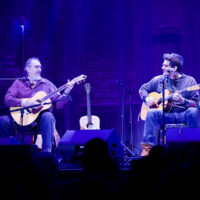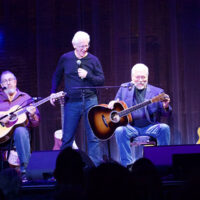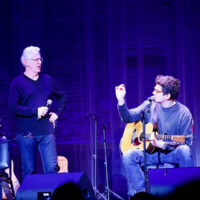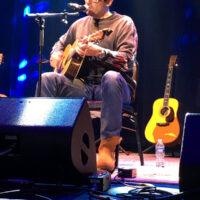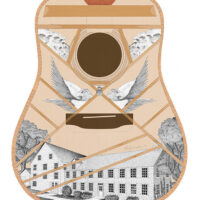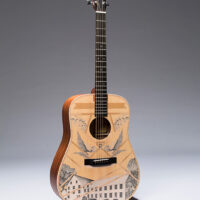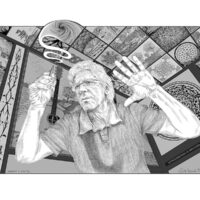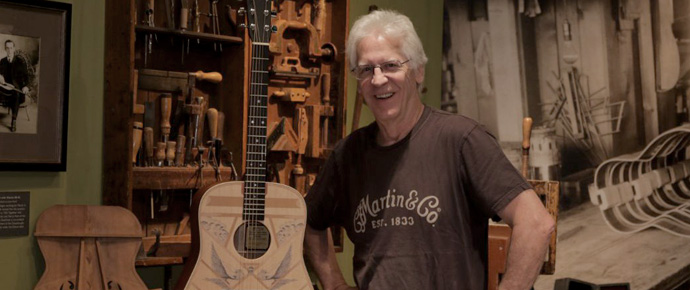
All of us know at least one person who seems to have a dream job. Doing something they love so much, that they would probably have done it without being paid, but yet also being handsomely rewarded for the job. It’s just not fair.
For Dick Boak, who recently retired from CF Martin & Co after more than 40 years of service, reflecting on his work life does sometimes feel like a dream. Meeting some of the biggest stars in the guitar firmament, working alongside the top craftsmen and luthiers, and spending time around the most historic steel string guitars ever made would seem like a fantasy for most any young guitar nut getting started on a career.
His Martin work experience started at the back door, and eventually led to Boak helping deign the company’s Eric Clapton model (000-28EC) and managing Martin’s Custom Shop. And becoming close with the company’s current director, C.F. Martin, IV, known at the plant as Chris.
Dick lived in Bethlehem, PA in the mid-1970s, and worked as an art teacher in New Jersey. His daily commute took him through Nazareth where the Martin factory was located, and it piqued his interest. He was deeply into woodworking, and had built a few guitars that he wouldn’t show anyone today, so he took the factory tour and asked the tour guide what they did with scrap wood that they couldn’t use. When he found out that they threw it in the dumpster, he started making regular trips there himself to pull out pieces of wood that he could use for his art, or his own guitars. Just because it wasn’t good enough for a Martin didn’t mean that a young hobby builder couldn’t use it.
So after what he imagines must have been 500 episodes of dumpster diving, Boak says the he got to know a bunch of the guys who worked at the factory.
“I got to know the shop foreman who started saving special pieces of wood for me that they couldn’t use. He called me ‘the kid.’
One day he asked what I did with the wood, and I told him I had made some lathe turnings, jewelry boxes and a few instruments. He then asked if I would bring some next time I came. When I did, he asked if he could take them around the shop, to show everyone what ‘the kid’ had made. Along the way he ran into C. F. Martin III, Chris’ grandfather.
The foreman brought the instruments back to me and said, ‘The old man says you should apply for a job.’ I was filthy from the dumpster, but I went up to the front door and told the receptionist I wanted to apply for a job. She looked at me like I was nuts, and told me that the only position available was for a draftsman. I applied, and as luck would have it, I started working for them shortly thereafter.”
His first assignment was creating draftings of all the various parts and assemblies of all of the Martin models. The idea was to be able to capture the exact Martin production specifications and assist in specifying the lower budget Sigma guitars being made in Japan. Once that was completed, they put him on odd jobs and short term projects, one of which led to Dick being fired for insubordination.
“They had brought in an engineer that became my boss, and he didn’t know anything about stringed instruments. He ordered me to make changes to the specifications of the Vega top tension hoops we were making, that would have caused them to break. I knew that would happen, and went to the personnel director to tell him, not realizing that he was a fishing buddy with my new boss. I was fired the next morning.
During the three months that I was fired, I did a detailed illustration of a D-28 and after publishing a small edition, I framed one and took it to Chris’s grandfather as a gift – and perhaps as my reapplication for employment. He hadn’t known that I had been fired, and he arranged quickly to bring me back. Most all of the tension hoops had broken just as I had predicted!”
After he was rehired, Dick was put in charge of Martin’s 1833 Shop, and A Woodworker’s Dream supply shop at the old North Street factory.
“We expanded the accessories by a lot, and gave the newly-formed telemarketing department many accessories to sell. I also ran the sawmill over at the main plant, and eventually that led me to MoMex, our Mexican division. They were starting a small string winding plant down there, and I helped them get their paperwork and procedures in order.”
But the position he really wanted was in advertising.
“We were using an ad agency at the time that, in my opinion, didn’t really understand the guitar market. This would have been the mid-’80s. So we brought it all in house at the dawn of desktop publishing. After about 8 years, Eric Clapton appeared on MTV Unplugged and we started getting all sorts of calls about what he was playing. I asked Chris if I could contact Clapton about an artist model, and we designed a guitar together that turned out to be extremely popular.
We sold 461 guitars with a retail price of $7200 apiece, and the success led to the formation of Martin’s Artist Relations Department. (Prior to that, Martin preferred to refer professional musicians to authorized dealerships.) We worked with Marty Stuart, Johnny Cash, Willie Nelson, Paul Simon, Sting, Crosby, Stills and Nash, and many other legendary artists. It was an immense amount of fun for me to pay tribute to the musical heroes of my youth, and it helped to recapture Martin’s important role in American music.
With Chris Martin’s open-mindedness to do new things, we really grew as a company, and I’m proud to have been a part of that. He gave me a long leash to try new things and go in new directions.”
Dick also assumed management of their Sounding Board magazine, that was published bi-annually to introduce new products to Martin owners. It was a high-quality publication, full of user tips, plus both Martin history and stories about new developments. With his computer and art skills, he was the obvious man for the job.
“Eventually I shed some of these many responsibilities and started focusing mostly on book projects, the museum and the archives. I helped coordinate a yearlong exhibition at the Metropolitan Museum of Art in New York, and developed a lot of friendships there. We had a number guitars from our museum, plus pieces from the private collection of Peter Szego, who wrote the companion book for the exhibit – Inventing The American Guitar. All of this emerged from a group we created called the Early Martin Guitar Summit that met for two extended seminars to investigate 19th century Martin guitars. A lot of research was done to trace the chronology and evolution of the acoustic guitar in America.
I was always interested in bringing back older models no longer in production. Chris was really interested in that too, and it led to the Custom Shop. The Custom Shop led to the creation of the Vintage Series, which led to the Golden Era, and eventually Chris took it to the next level with the Authentic series. We had to relearn our own processes to make them the old way, but the guitars have been worth the effort.”
With 41 years in with Martin, the notion of retirement starting hitting him not long ago.
“For the last year I was starting to think that I had saved enough, and at 68 years old I didn’t want to outstay my welcome. I saw some older employees that weren’t able to enjoy their retirement. I wanted to have some fun, and do some things I had let go by the wayside.”
In January he organized a retirement concert at the historic State Theatre in Easton, PA. Figuring that a live show would be more fitting than a retirement dinner at the Holiday Inn, he asked his friend, legendary rock guitarist Steve Miller, whether he would to be part of it. Miller said yes, as long as he could be the Master of Ceremonies!
“He asked Marty Stuart and His Fabulous Superlatives if they would join in, then Jorma Kaukonen and David Bromberg jumped on board, and my friend and Martin artist Craig Thatcher. With such a lineup, I asked John Mayer if he would like to do it, and he agreed as well. Everything was ready to go, and then the big snowstorm hit right after New Years, and flights started to be cancelled. Marty and his band had to drop out, but everyone else made it, and Steve brought Nick Forster (Hot Rize) and cowboy guitarist Ernie Sites along. It was a marvelous concert.”
They called it Boak’s Bash, aka the Last Schmaltz, and sold 1550 tickets with still more trying to get in.
“It’s a beautifully restored theater from the gilded age, and it was filled with friends and fellow employees from my work at Martin, plus my own family and friends. I was also able to exhibit my art on site. It couldn’t have been better.”
And so Dick Boak is now a free man, returning to his early artistic passion for illustration, and playing guitar. He has recorded two CDs with his friend Chris Thatcher, and is actively creating new illustrations. But he said he’ll always feel an attachment to Martin.
“I’ve told everyone at Martin that I’ll be happy to pitch in where needed, so I have some speaking engagements, and possibly a visit Japan to support our Martin distributor there.”
In addition to art and music, Dick has a part time job helping his rather famous next door neighbor in Nazareth archiving a large collection of photographs. He is able to work at a comfortable pace, and enjoys learning about the auto racing world.
You can view Boak’s pen and ink drawings online at dickboak.com, where he offers his writing, music, woodworking, and guitars. At his leisure, of course. He calls the style he employs pointillist, and “approximations of impossibility.”
Well done, Dick Boak. A life well lived, and it’s not over yet!
Dick also graciously shared these images from his farewell concert and his art work.



